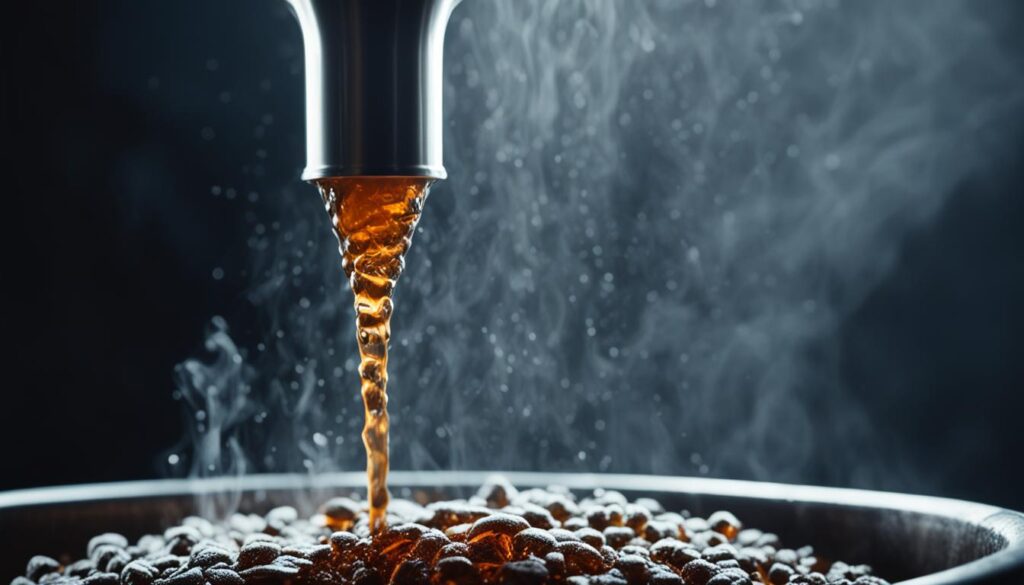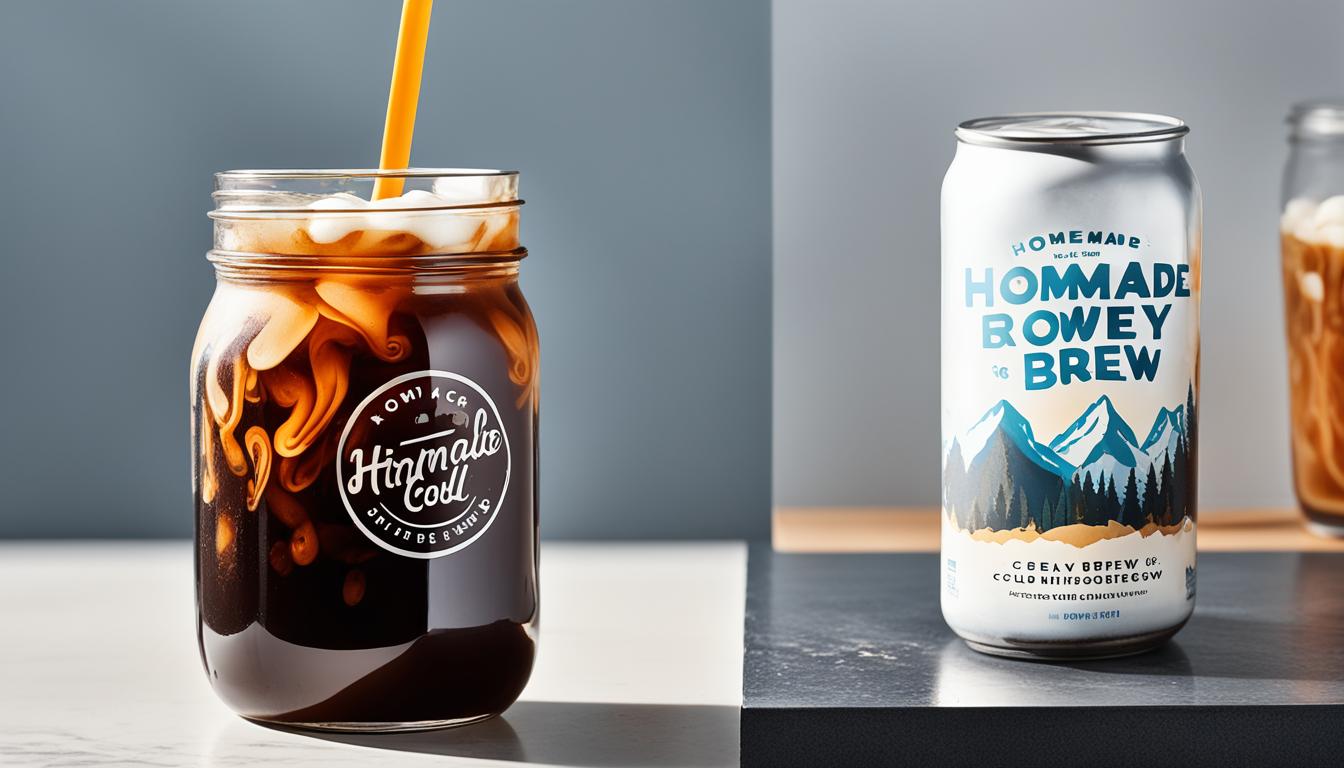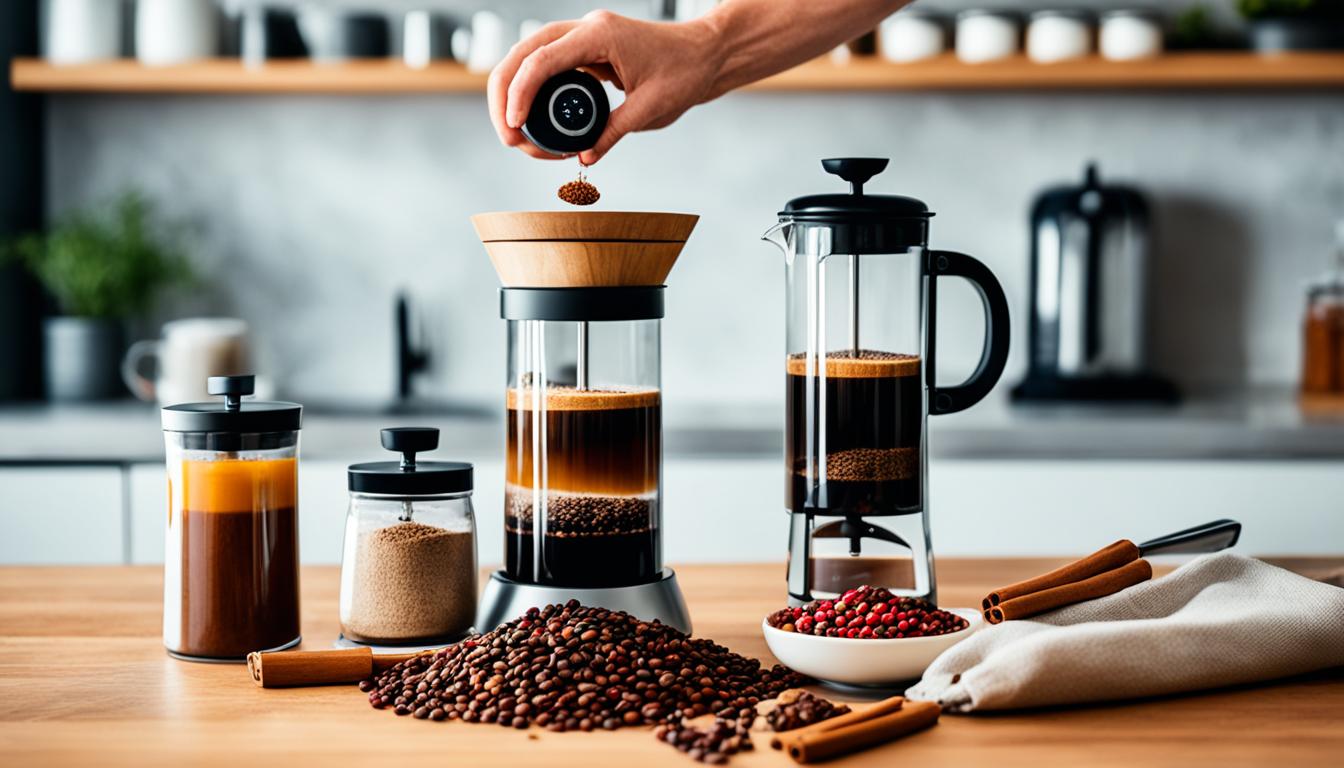Nitro cold brew has taken the coffee world by storm with its creamy texture and smooth taste. If you’re a fan of this refreshing beverage, you might be wondering how you can enjoy it in the comfort of your own home. Well, we’ve got you covered!
In this quick guide, we will walk you through the process of making your own homemade nitro cold brew. Say goodbye to expensive coffee shop visits and hello to the satisfaction of DIY nitro coffee. Get ready to impress your taste buds with this easy-to-follow nitro coffee recipe.
Key Takeaways:
- Making nitro cold brew at home is easier than you think.
- You’ll need the right equipment and knowledge to achieve the perfect creamy texture.
- Cold brew kegs are game-changers for nitro coffee enthusiasts.
- A great starting point for nitro coffee is high-quality cold brew coffee.
- Follow step-by-step instructions to make your own cold brew coffee.
What is Nitro Coffee?
Nitro coffee is a cold brew coffee infused with nitrogen gas. The nitrogen gas gives the coffee a creamy and smooth texture, similar to that of a Guinness beer. It also enhances the natural flavors of the coffee and reduces its acidity, resulting in a more refreshing and enjoyable drinking experience.
The nitrogen bubbles create a visually appealing cascading effect, making nitro coffee a visually stunning beverage as well.
Experience the unique and indulgent taste of nitro coffee, with its creamy texture and smooth taste. The infusion of nitrogen gas takes your coffee to a whole new level, transforming it into a luxurious treat for your taste buds. With each sip, you’ll be captivated by the rich, velvety mouthfeel and the delightful cascading effect of the nitrogen bubbles.
Whether you’re a coffee connoisseur or simply looking for a refreshing twist on your daily caffeine fix, nitro coffee offers an unforgettable experience. Try it for yourself and elevate your coffee game to new heights.
The Cold Brew Keg: A Game-Changer for Nitro Cold Brew Coffee Enthusiasts
The cold brew keg is a high-quality system designed specifically for making and serving nitro cold brew coffee at home. It consists of a stainless steel keg, a nitro faucet, and a nitrogen cartridge holder. The cold brew keg infuses the cold brew coffee with nitrogen gas, creating the signature creamy texture and cascading effect of nitro-infused cold brew.
Using a cold brew keg at home offers several benefits for homemade nitro cold brew lovers:
- Cost savings: With a cold brew keg, you can enjoy homemade nitro cold brew at a fraction of the cost of purchasing it from a coffee shop. Buying a cold brew keg is a one-time investment that will save you money in the long run.
- Convenience: Having a cold brew keg at home means you can have nitro cold brew readily available whenever you want. No need to wait in line or make a trip to the coffee shop; you can simply pour yourself a glass of refreshing nitro coffee whenever the craving strikes.
- Customization: The cold brew keg allows you to customize the flavor and strength of your nitro cold brew according to your taste preferences. You can experiment with different coffee beans, brewing times, and even add flavorings or sweeteners to create a personalized nitro coffee experience.

“The cold brew keg revolutionized my nitro coffee game. Not only did it save me money, but I also get to enjoy freshly made nitro cold brew with the exact flavor profile I love. It’s a game-changer!” – Sarah, Nitro Coffee Enthusiast
The cold brew keg is a must-have for anyone who enjoys the smooth and creamy texture of nitro cold brew. With its cost savings, convenience, and customization options, it’s the ultimate tool for creating your own homemade nitro coffee experience.
Great Nitro Coffee Starts with High-Quality Cold Brew Coffee
To make great nitro coffee, we need to start with high-quality cold brew coffee. Cold brew coffee is made through a steeping process that extracts the flavors from coarse-ground coffee beans. This method involves steeping the coffee grounds in water at low temperatures for an extended period of time, usually 12-24 hours. The slow steeping process allows for flavor extraction while minimizing the acidity of the coffee, resulting in a smooth and concentrated brew.
Using freshly roasted and high-quality coffee beans is crucial for achieving the best flavor and aroma in cold brew coffee. The choice of coffee beans will greatly impact the taste and richness of your nitro coffee. Opt for beans that are specifically labeled for cold brew or have tasting notes that align with your preferred flavor profile. Experimenting with different types of coffee beans can lead to exciting discoveries and unique flavor combinations in your nitro brew.
The final step in the cold brew process is removing the coffee grounds from the liquid. This can be done by straining the cold brew through a fine-mesh sieve or using a cold brew coffee maker with a built-in filter. The result is a flavorful concentrate that is ready to be transformed into nitro coffee.
So, remember, starting with high-quality cold brew coffee sets the foundation for a delicious and satisfying nitro coffee experience. Take the time to source the best coffee beans, perfect the steeping process, and savor the smooth and concentrated flavors of your homemade nitro coffee.
“Starting with high-quality cold brew coffee sets the foundation for a delicious and satisfying nitro coffee experience.” – Our Nitro Coffee Experts
Step-by-Step Instructions for Making Cold Brew Coffee
Making cold brew coffee is a simple process that requires just a few steps. Follow our guide below to brew a delicious and refreshing cold brew coffee at home.
Step 1: Grind the Coffee Beans
Start by coarsely grinding your coffee beans. This helps with proper extraction and ensures a rich and flavorful cold brew.
Step 2: Combine Coffee and Water
Add the coffee grounds to a jar or pitcher and pour filtered water over them. The water-to-coffee ratio typically ranges from 1:1 to 1:2, depending on how strong you prefer your coffee.
Pro Tip: You can experiment with different ratios to find the perfect balance for your taste buds.
Step 3: Steep the Coffee
Let the coffee steep for 12-24 hours. The steeping time can vary based on your preference. If you want a stronger and more concentrated flavor, opt for a longer steeping time. You can steep the coffee at room temperature or in the refrigerator, depending on your preference.
Step 4: Remove the Coffee Grounds
Once the steeping process is complete, remove the coffee grounds from the mixture. This will leave you with a smooth and concentrated cold brew coffee.
Pro Tip: Use a fine mesh strainer or a cheesecloth to remove any sediment or fine coffee particles.
| Cold Brew Coffee Brewing Process | |
|---|---|
| Grind the coffee beans coarsely | |
| Combine coffee and water in a jar or pitcher | |
| Let it steep for 12-24 hours | |
| Remove the coffee grounds |

Now that you’ve successfully brewed your cold brew coffee, you can use it as a base to create refreshing nitro cold brew or enjoy it over ice for a smooth and satisfying cold coffee experience.
Setting Up the Cold Brew Nitro Keg
Now that you have your cold brew coffee ready, it’s time to set up the cold brew nitro keg. Follow these simple steps to get started:
- Filling the Keg: Begin by filling the keg with your delicious cold brew coffee. Make sure to leave some space at the top for the nitrogen gas to form. This will allow for the perfect infusion of nitrogen into your coffee, creating that smooth and creamy texture.
- Installing the Faucet: Attach the nitro faucet to the keg, making sure it is tightly installed. This will ensure a secure and leak-free connection, allowing you to dispense your nitro cold brew with ease.
- Inserting Nitrogen Cartridges: Next, it’s time to insert the nitrogen cartridges into the nitrogen cartridge holder. Be sure to follow the recommended amount for your keg size. These cartridges are what will infuse your cold brew coffee with the nitrogen gas, creating those beautiful cascading bubbles and enhancing the flavor.
- Allowing the Gas to Settle: Once you’ve inserted the nitrogen cartridges, let the keg sit for a while to allow the gas to absorb into the coffee. This will ensure that the nitrogen is evenly distributed throughout the keg.
- Shaking and Refrigerating: After the gas has settled, give the keg a good shake to ensure proper mixing of the coffee and nitrogen. Then, refrigerate the keg for at least 1 hour before serving. This chilling process helps to maintain the optimal temperature and ensures the best possible flavor and texture.
- Consistent Foam: For consistent foam and optimal results, make sure to shake the keg thoroughly after each cartridge insertion and before pouring the first cup of the day. This will help create that luscious layer of foam that makes a nitro cold brew truly special.
With your cold brew nitro keg properly set up, you’re now ready to enjoy the rich and creamy goodness of nitro-infused coffee in the comfort of your own home. Sit back, relax, and indulge in the velvety smoothness of each sip.
Understanding N2O and N2 Cartridges: Cost, Texture, and Pouring Technique
When it comes to nitro coffee, the choice of cartridges can make a difference in both cost and texture. There are two main types of cartridges used for nitro coffee: N2O and N2.
N2O cartridges contain nitrous oxide and are commonly used in whipped cream dispensers. They are easy to obtain and cost around 60 cents per 8-gram cartridge.
N2 cartridges, on the other hand, contain pure nitrogen and are a bit more expensive, costing around one dollar each.
When deciding which cartridge to use, personal preference and budget play a significant role. Both N2O and N2 cartridges can create a creamy texture in nitro coffee, but there is a difference in the end result.
Nitrogen gas provides a creamier and sweeter cream, while nitrous oxide results in more foam.
Furthermore, the pouring technique varies depending on the gas used.
- Nitrogen gas requires a straight pour, ensuring a smooth and consistent flow.
- Nitrous oxide, on the other hand, benefits from a slight angle pour to maximize foam production.
Understanding the nuances of N2O and N2 cartridges allows you to tailor your nitro coffee experience to your preferences. Whether you prefer a creamier texture or a foamier cup, experimenting with different cartridges and pouring techniques can enhance your enjoyment of homemade nitro coffee.
The image above illustrates the different types of cartridges used in nitro coffee preparation.
Conclusion
Mastering nitro cold brew and enjoying the perfect homemade nitro coffee is a delightful and rewarding experience. By following the steps outlined in this quick guide and using the right equipment, you can become a true master of crafting nitro coffee in the comfort of your own home.
Start by selecting high-quality cold brew coffee as the foundation of your nitro coffee creation. The smooth and concentrated flavors extracted through the cold brewing process will provide the perfect base for your homemade nitro coffee.
Next, set up your cold brew nitro keg, infusing your cold brew coffee with the nitrogen gas that will give it that creamy texture and visually stunning cascading effect. Take the time to understand the differences between N2O and N2 cartridges, as they can influence the texture and foaminess of your nitro coffee.
With all the elements in place, it’s time to unleash your creativity and experiment with different flavors and combinations. Whether you prefer a classic nitro cold brew or desire to explore unique flavor profiles, the possibilities are endless. Sit back, savor every sip, and enjoy the delicious coffee experience that you have seamlessly crafted at home. Cheers!
FAQ
What is nitro coffee?
Nitro coffee is a cold brew coffee infused with nitrogen gas, creating a creamy and smooth texture, similar to a Guinness beer. It also enhances the natural flavors of the coffee and reduces its acidity, resulting in a refreshing and enjoyable drinking experience. The nitrogen bubbles create a visually appealing cascading effect, making nitro coffee visually stunning as well.
What is a cold brew keg?
A cold brew keg is a high-quality system designed for making and serving nitro cold brew coffee at home. It consists of a stainless steel keg, a nitro faucet, and a nitrogen cartridge holder. Using a cold brew keg offers several benefits, including cost savings compared to purchasing nitro coffee from a coffee shop, convenience of having nitro coffee readily available, and the ability to customize the flavor and strength of your nitro cold brew according to your taste preferences.
How do I make cold brew coffee?
Making cold brew coffee is a simple process. Start by coarsely grinding your coffee beans, then add the coffee grounds to a jar or pitcher and pour filtered water over them. Let the coffee steep for 12-24 hours at room temperature or in the refrigerator. After the steeping process is complete, remove the coffee grounds, and you’ll be left with a smooth and concentrated cold brew coffee that can be used to make nitro coffee.
How do I set up the cold brew nitro keg?
Start by filling the keg with cold brew coffee, leaving some space for the nitrogen gas to form. Attach the nitro faucet to the keg, ensuring it is tightly installed. Then, insert nitrogen cartridges into the nitrogen cartridge holder, following the recommended amount for your keg size. Let the keg sit for a while to absorb the gas and then shake it well. Refrigerate the keg for at least 1 hour before serving.
What are N2O and N2 cartridges?
N2O cartridges contain nitrous oxide and are commonly used in whipped cream dispensers. They are easy to obtain and cost around 60 cents per 8-gram cartridge. N2 cartridges, on the other hand, contain nitrogen and are more expensive, costing around one dollar each. The choice between N2O and N2 cartridges depends on personal preference and budget.
How do N2O and N2 cartridges affect the texture and pouring technique?
Nitrogen gas provides a creamier and sweeter texture, while nitrous oxide results in more foam. The pouring technique also differs depending on the gas used, with nitrogen gas requiring a straight pour and nitrous oxide needing a slight angle pour.




